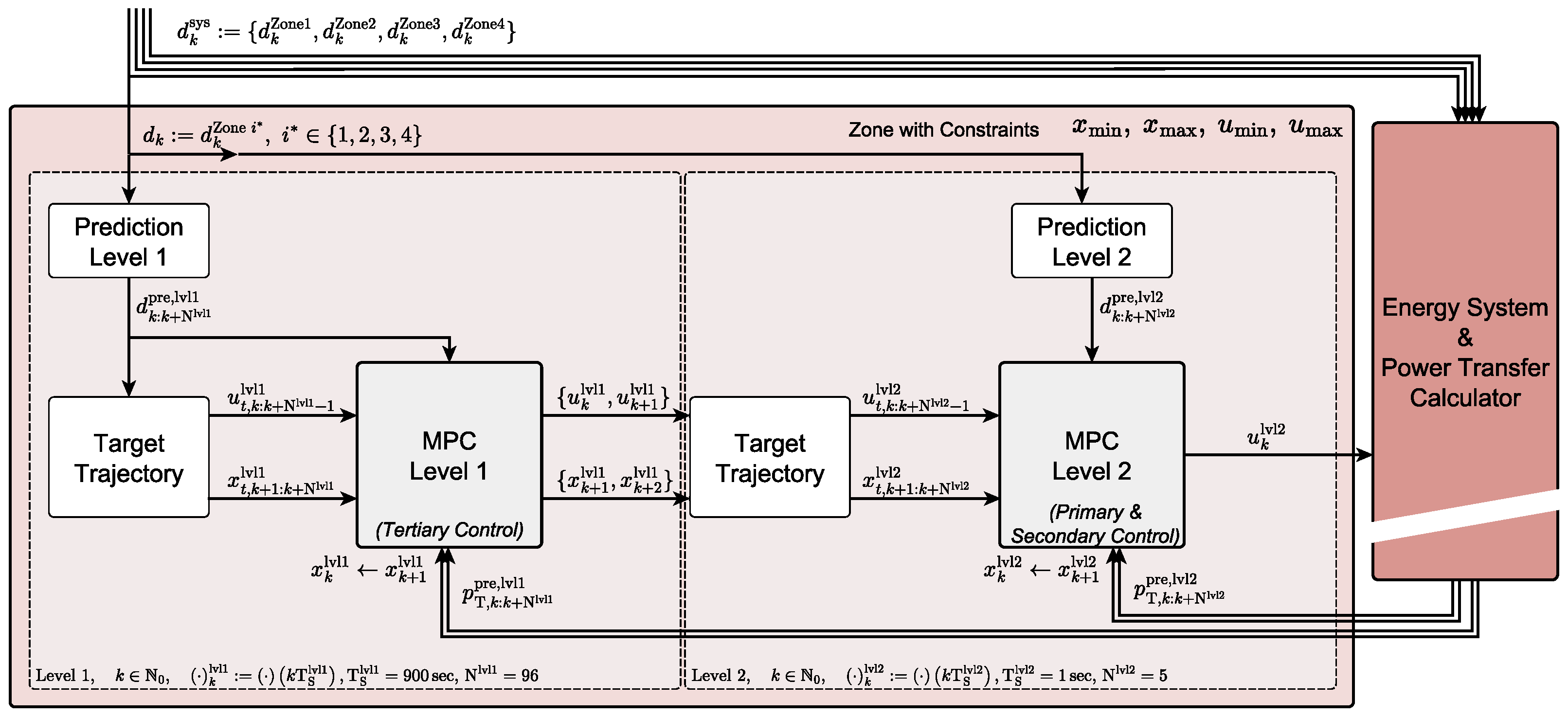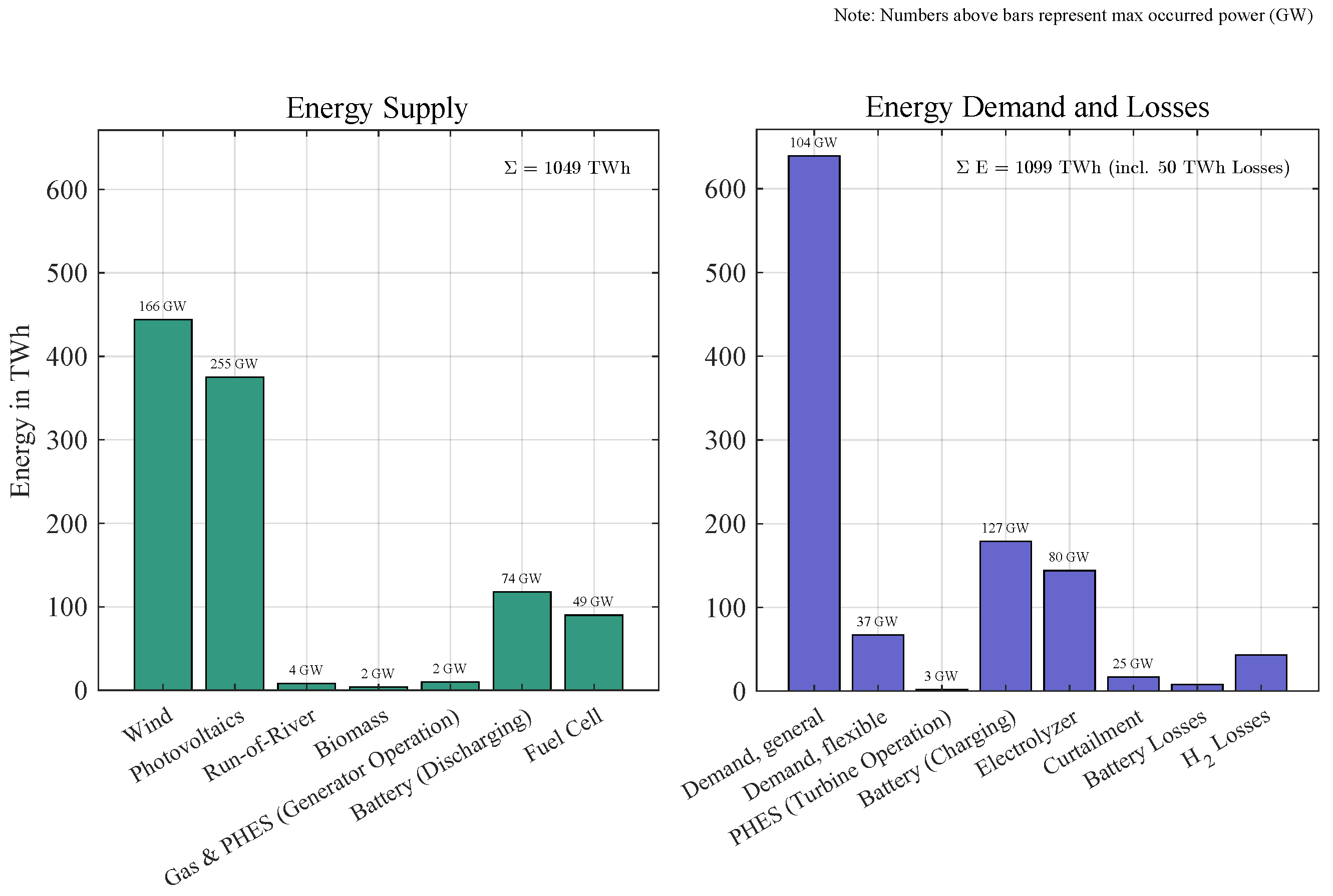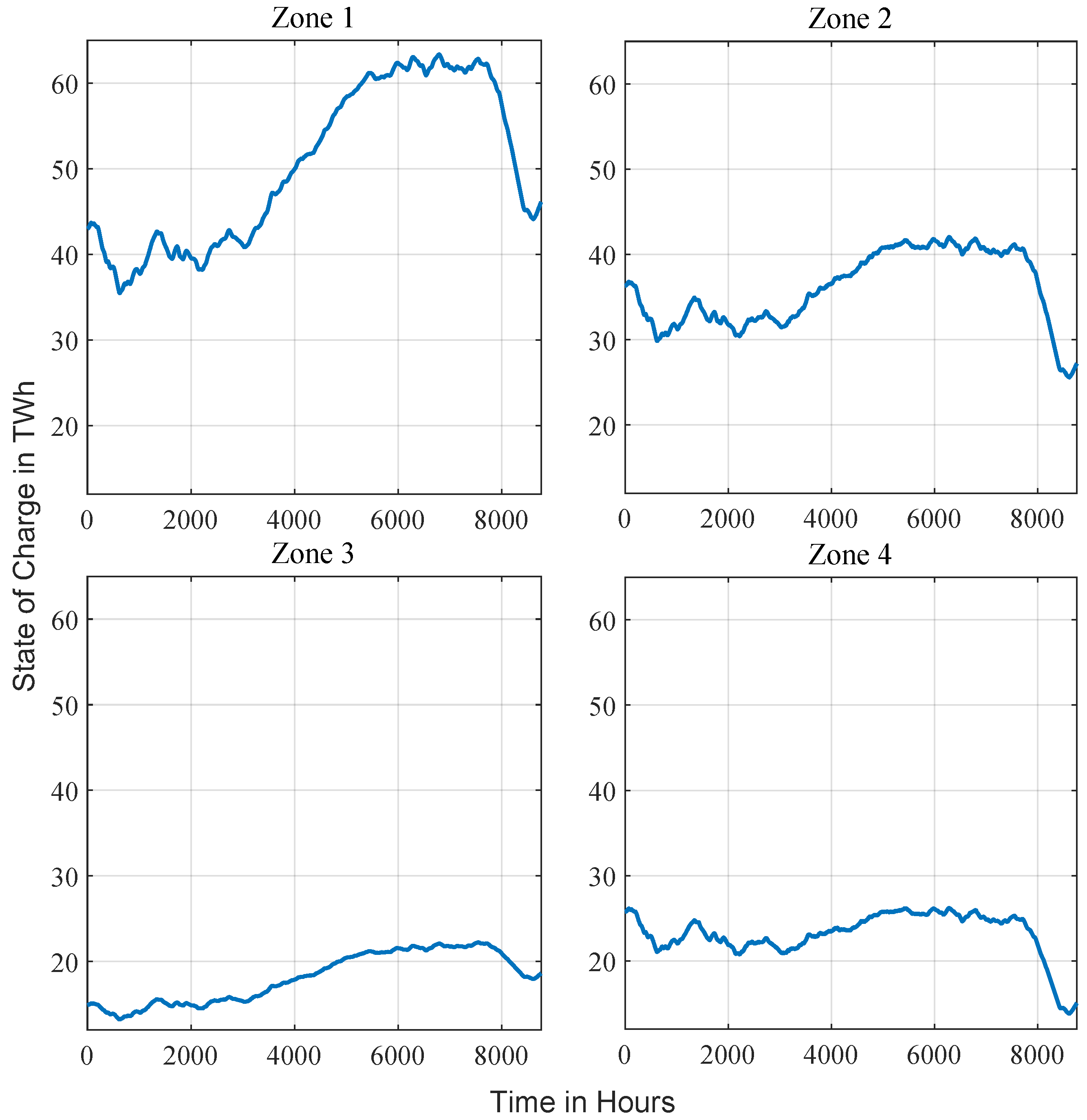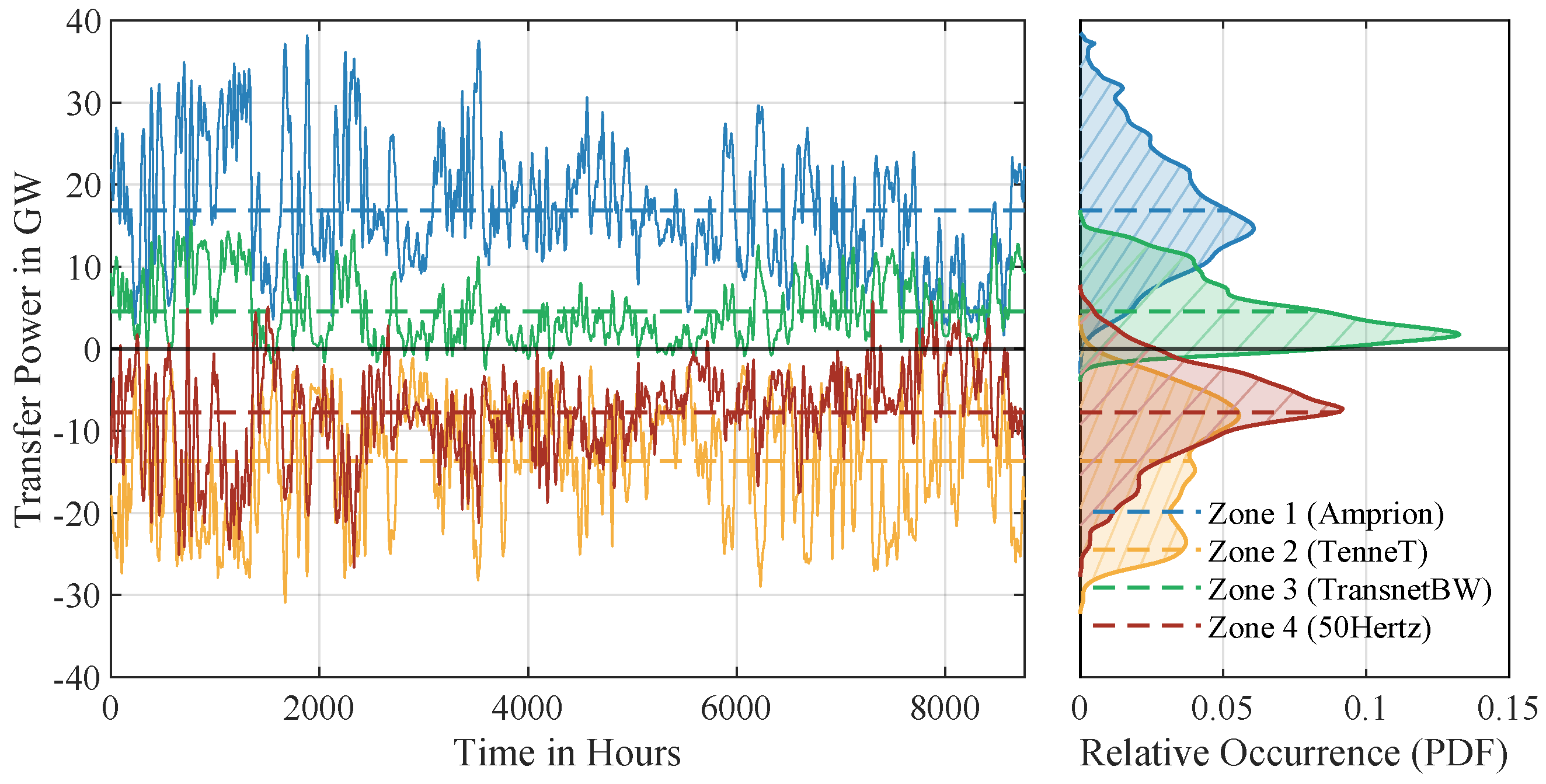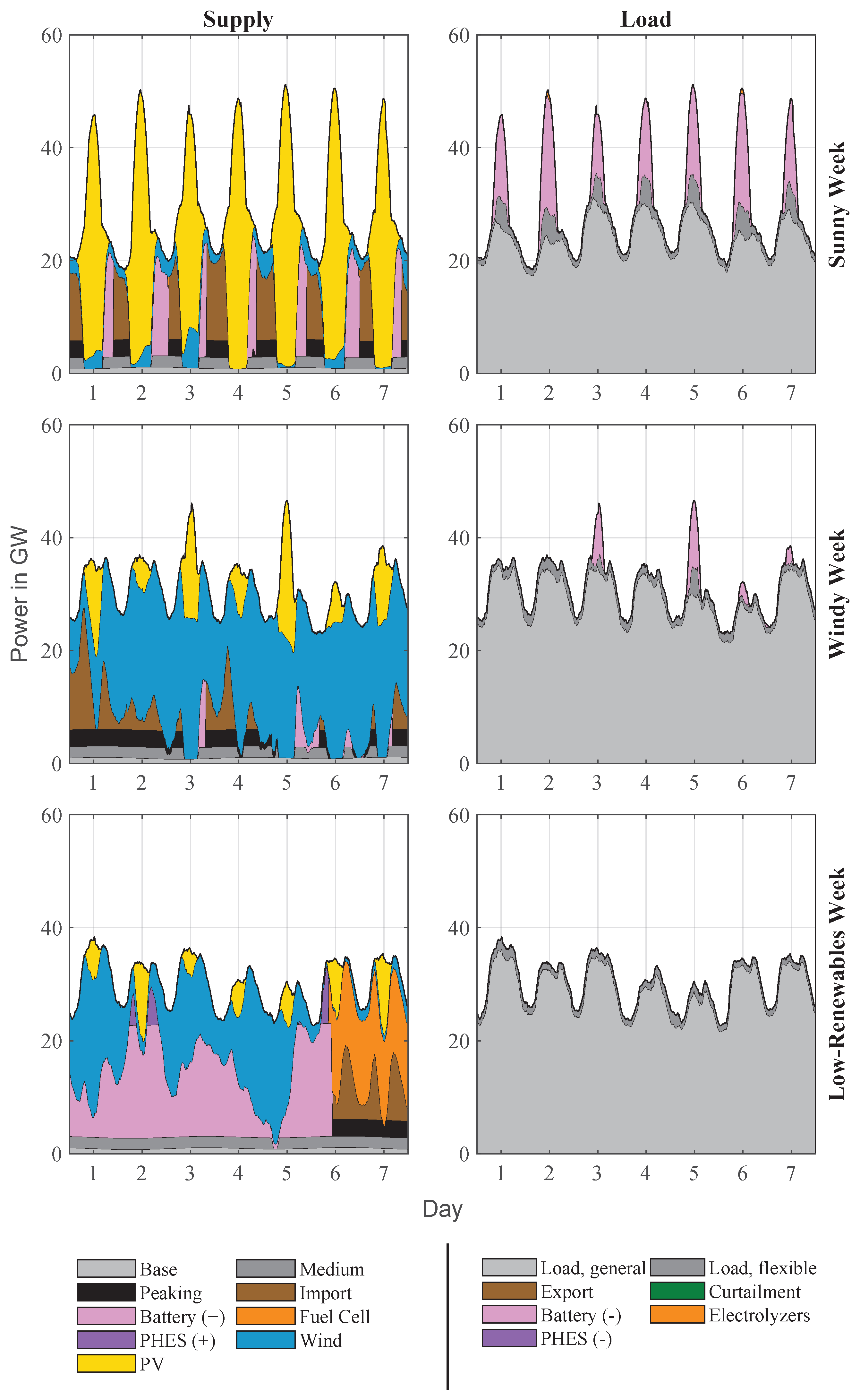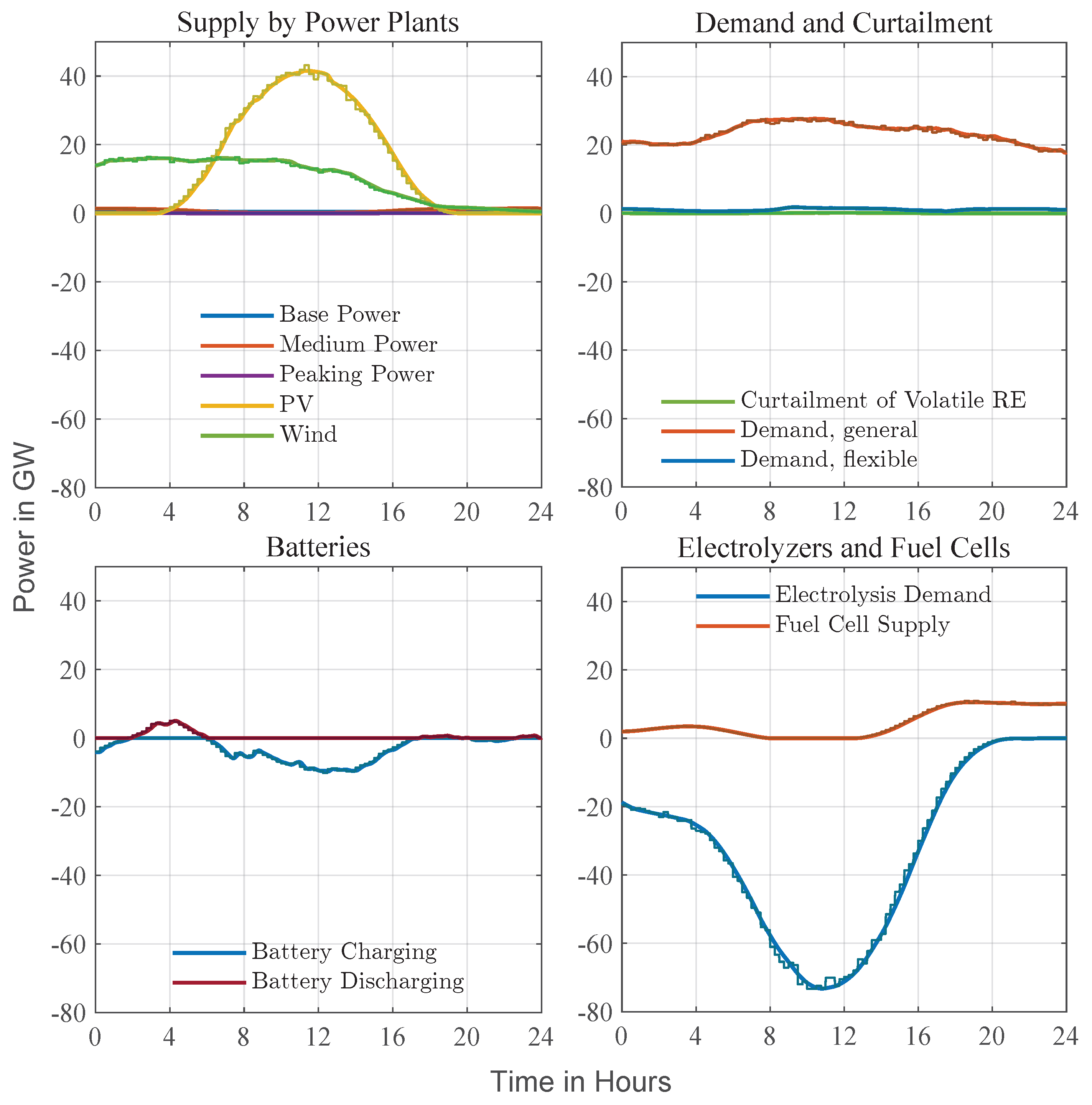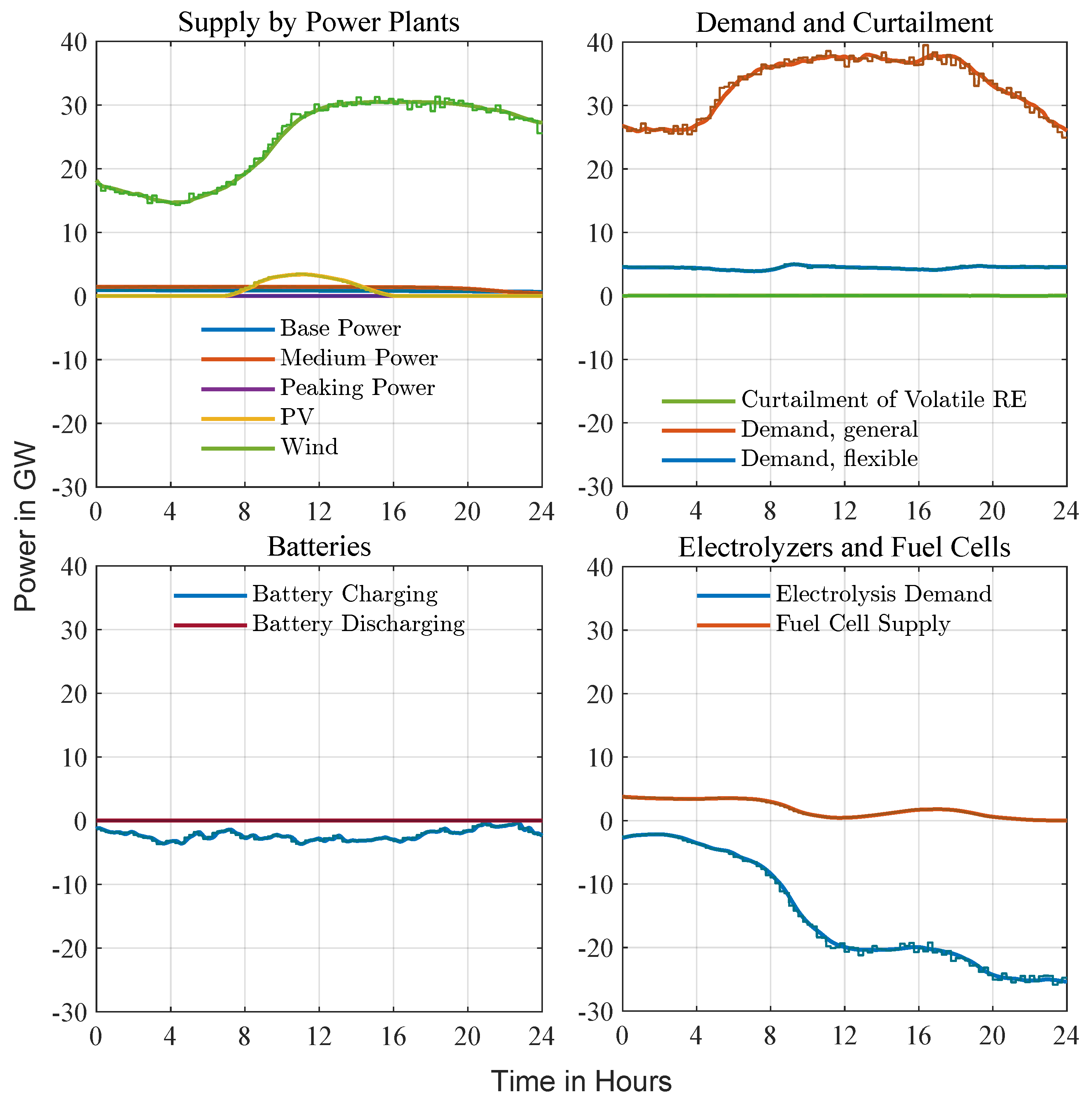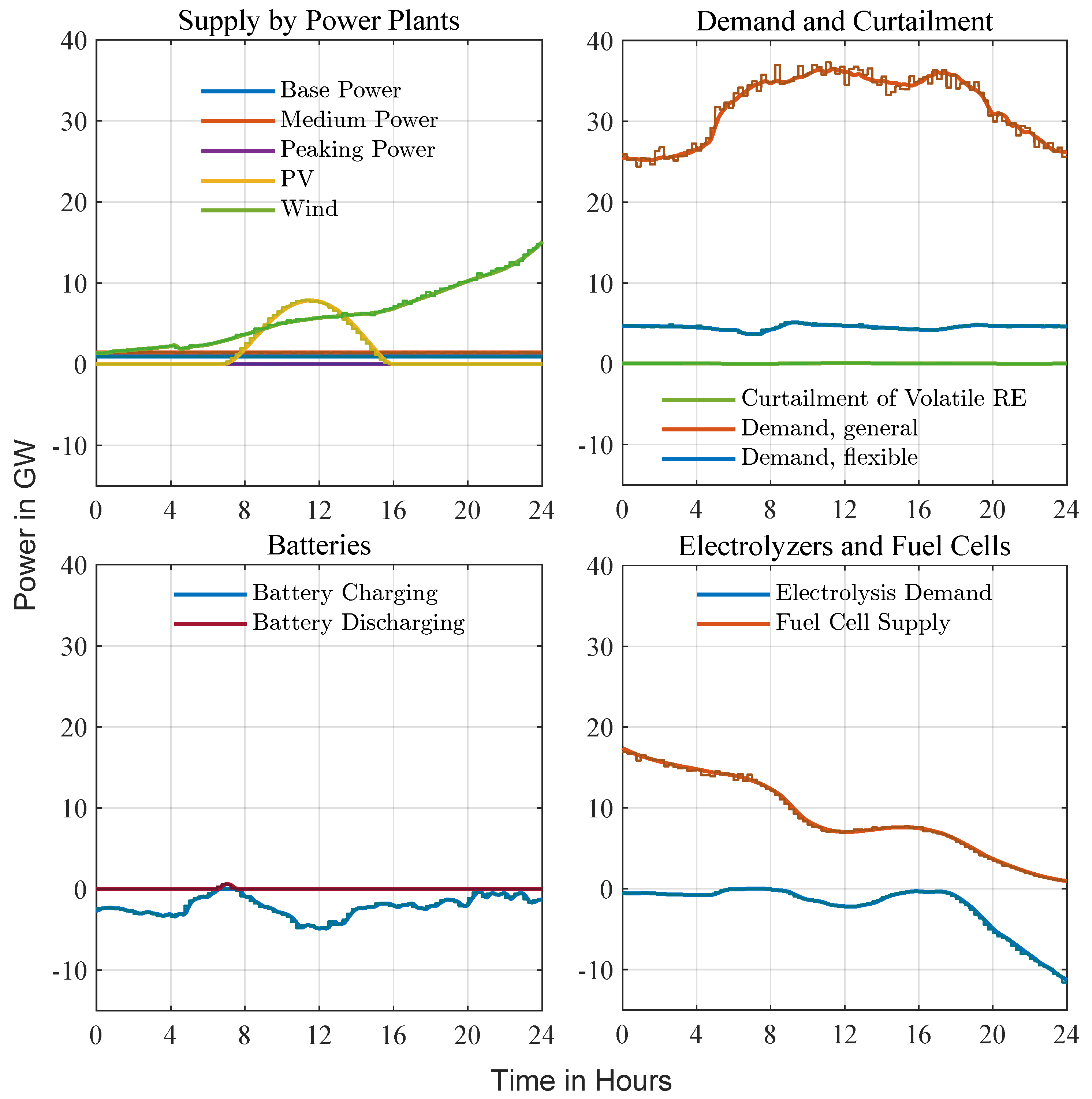The methodology section is organized into two main sections: the HiMPC framework and the Energy System’s Components and Parameterization. In the model’s framework, the outer MPC (referred to as Level 1 in the following) is responsible for maintaining power balance with a 15-min sampling time and utilizes forecast data for 24 h to determine optimal setpoints. The inner MPC (designated as Level 2) operates with a 1-s sampling time and focuses on short-term frequency regulation to ensure system stability. All zones are interconnected to maintain equilibrium and balance power distribution across the system. The second section focuses on defining the system’s components and their parameterization, providing a comprehensive overview of their operational constraints and limitations.
2.1. HiMPC Framework
The objective of frequency stabilization is to maintain the target grid frequency of 50 Hz by ensuring a balance between power generation and consumption. This process is divided into primary, secondary, and tertiary control, which are differentiated by their response times and specific functions. Although traditional frequency regulation methods are effective for systems with large, centralized power plants, they can cause instability in systems dominated by small, decentralized units and highly variable renewable energy sources, which is primarily due to the diminished stabilizing effects of rotating masses. The heightened instability and the inherent variability of wind and photovoltaic power require more rapid response times for power adjustments [
32,
33,
34].
To model frequency dynamics, an equation is required to capture the interdependencies between grid frequency, loads, and power plant characteristics, beginning with the derivation of the linearized dynamics of the generators’ oscillations, which are represented by
In this equation, denotes the deviation from the nominal frequency, , while H represents the absolute inertia constant, is the absolute nominal power, and refers to the absolute mechanical power of the generator. The load power is denoted as .
We adopt a lossless transmission approximation: ohmic line losses and reactive-power effects are neglected, and each control zone is modeled as a copper plate with power balance enforced on net exchanges rather than detailed AC power-flow equations. This isolates the controller’s behavior and keeps the optimization tractable; incorporating losses and network constraints is deferred to future work. The oscillation equation indicates that only power changes, and , are pertinent to frequency-stabilizing control. When these changes are perfectly balanced, no frequency deviation occurs. Ideally, any load variation should be compensated by a corresponding adjustment in generation, underscoring the critical importance of maintaining power balance for frequency stability.
Deriving a frequency model involves incorporating frequency-dependent loads, which introduces additional terms, resulting in
Here, the frequency dependency of the system’s loads is described by
and
, both of which vary with load dynamics; the former represents the loads’ damping, while the latter accounts for the kinetic energy of the generator’s rotating masses. Based on this, the state-space model is derived as
with the parameters
In this form,
reflects the effect on frequency deviation, whereas
relates to both power generation and load consumption, with the inertia constant
H being computed as
It is assumed that conventional power plants have an inertia constant of
and wind turbines have
[
33]. Based on findings in [
34,
35] among others, it is suggested that new variable-speed wind turbines contribute to grid stabilization by increasing their rotational inertia. Assuming that the wind turbines in the considered future scenario possess this capability, the constant of the relevant power of the wind turbines is approximated using the average power over the simulated period. For the power plant capacity, the total nominal power is used, which includes the base load, medium load, and peak load, as determined by
The damping coefficient for frequency-dependent loads,
, suggests that load variations typically range from 0% to 2% for each 1% change in frequency and can be approximated using
as proposed by Andersson [
36]. In simulations involving a single zone,
remains constant; however, it can vary across different zones and simulation scenarios.
2.1.1. Power System Setup
Figure 2 depicts the fundamental architecture of the HiMPC employed in this study, outlining the control strategy for a single control zone while preserving the traditional division into primary, secondary, and tertiary controls typical of classical frequency regulation.
Level 2 MPC combines primary and secondary control. It runs at a 1 s sampling time with a 5 s prediction horizon. The fast loop applies a droop-like action proportional to the instantaneous frequency deviation to arrest transients (primary role) and, in parallel, an integral correction that drives the steady-state frequency error toward zero within actuator limits (secondary role). A sampling time of 1 s is intentionally coarse; sub-second sampling on the order of a few hundred milliseconds or less would better suit low-inertia conditions. An optional intermediate third layer with a sampling time of a few tens of seconds can further smooth corrections between the 1 s loop and the 15-min scheduler. We keep 1 s/5 s here to limit runtimes; for the types of questions this framework is intended to support—e.g., storage sizing, ratios of storage power to plant capacity, and sensitivity to forecast quality—this simplification does not limit its applicability, although we do not perform those analyses here.
Level 1 MPC provides tertiary control. Fast frequency dynamics are not represented at this layer. Instead, Level 1 optimizes the power balance on a 15-min grid over a 24-h horizon, embedding forecasts and slower plant dynamics such as ramp-rate limits, start-up trajectories of power plants and electrolyzers, and storage charging/discharging constraints. Every 15 min, it issues setpoints for dispatchable units, storage, and sector-coupled loads. A trajectory generator converts these piecewise-constant setpoints into smooth second-scale reference trajectories for Level 2 to prevent steps at the layer interface. In effect, Level 1 pre-positions flexibility (charging, curtailment, commitment) while Level 2 closes the fast frequency loop.
The hierarchical formulation embeds all variables in constrained optimizations. The state vector contains controllable power outputs and storage states; the input vector represents commanded ramp rates; disturbances cover uncontrollable injections and withdrawals (wind, photovoltaic, and demand) with forecasts. Bounds on states and inputs, together with tracking of Level 1 references and frequency objectives, define the constraints and the cost function. Both layers operate in receding-horizon fashion: at each sampling instant, the respective MPC predicts over its horizon, solves the constrained problem, applies the first control move, and repeats with updated measurements and forecasts. Disturbances that occur just after a control update can cause larger excursions in low-inertia conditions when sampling is slow. The recommended mitigations are (i) using a shorter, sub-second Level 2 sampling time, and/or (ii) inserting an intermediate layer with a sampling time of a few tens of seconds that relieves the 1 s loop from large setpoint steps; both are compatible extensions of the presented architecture.
Optimal control behavior is achieved by minimizing these total costs through an optimization process based on a continuous-time state-space model, which is described by
This mathematical framework comprises several key components: the state matrix , which governs the dynamics of the system states; the input matrix for controllable variables; and the disturbance matrix for external influences. The system output is determined by the output matrix , influenced by the state vector, and further affected by inputs through the feedthrough matrix and disturbances through . In general, these matrices can be time-varying (for example, effective inertia depends on the operating point); to keep the computational burden manageable, we freeze them within this study, which is adequate for the capacity-sizing or adequacy-planning questions addressed by the proposed framework.
The continuous dynamics are converted into a linear model and discretized with the respective sampling time of each layer (
for the fast layer,
for the scheduler; an optional intermediate layer could use
) to make them suitable for the control algorithm. The discretization enables the controller to evaluate the system’s behavior at each time step
k, leading to
where future states and outputs are determined based on current states, inputs, and disturbances. The subscript
indicates the discrete form of the matrices used in this formulation.
2.1.2. Optimization Problem Setup
To compute the optimal solution, an optimization algorithm is required. In this work, the FORCES solver [
37] is used, which employs interior-point methods well suited for linear quadratic problems. The state-space model, previously introduced, is reformulated as a quadratic programming problem to enhance computational efficiency and structure. This formulation minimizes a cost function
J over a prediction horizon
, taking into account system states
, inputs
, and disturbances
, which is formulated as
s.t.
ensure that the system states and inputs remain within predefined bounds, the initial state
matches the current system state
, and that the system dynamics are respected as per the given equations.
The objective function minimizes the deviations of the system states, , and control inputs, , from their reference trajectories, while also accounting for the impact of disturbances . The terms , and their cross-product terms represent the weighting matrices that define the importance of different states, inputs, and disturbances in the cost function. These weights assign priorities to the optimization variables based on their relative importance to the system’s overall performance. The optimization variables are normalized componentwise by their maximum absolute value; accordingly, the state-related weighting matrices are defined on the normalized states, while input and disturbance channels are handled via dedicated scaling matrices. The terminal cost guarantees system stability with the matrix obtained by solving the discrete-time algebraic Riccati equation over an infinite horizon. In this formulation, it is assumed that , as the interaction between states and inputs is not weighted, and the discretized cost function matrices are predefined.
Optimization solvers designed for sparse representations offer superior scalability relative to those tailored for dense forms. This advantage is particularly evident as complexity grows and the prediction horizon extends, enabling shorter computation times when utilizing the sparse form [
38]. To convert the optimization problem, given in (
12), into its standard form, the vectors and matrices are initially stacked into a sparse form, leading to
where the number of diagonally entered matrices in
and
equals
. However, in this configuration, the matrix
is excluded to prevent it from overly affecting the control with a shorter prediction horizon; the weighting matrix
is used instead. For the equality constraint in sparse form,
with the matrices
that may evolve gradually over time to account for changes in the system, such as the availability of storage through vehicle-to-grid integration. These adjustments are reflected by indexing the matrices, ensuring the optimization process adapts to the system’s dynamic conditions. This can then be rearranged to conform to the format required by the optimization solver, resulting in
The system boundaries are modeled as inequality constraints and arranged into a suitable stacked format, resulting in
with
that can be compactly expressed using the identity matrix
in the appropriate form
By rearranging and eliminating terms independent of the optimization variables, the discretized cost function, as shown in (
12), simplifies to
with its equality and inequality constraints defined in (
17) and (
20) forming its standardized structure, which is suitable for the FORCES solver.
The optimization framework is extended to include the system’s outputs, represented by the vector
, in a manner that enables more precise control over power generation. By appropriately weighting these outputs, the power levels in the state vector
are aggregated through the matrix
, allowing for a weighted balance of the system’s overall power balance, which is critical for frequency regulation. As a result, the optimization focus is shifted to the outputs in the following steps. Deviations from the setpoints, noted as
, are incorporated using the weighting matrix
. With the setpoints for the outputs defined as
, the formulation is given by
yielding the cost function to
or in its standardized form to
with
Based on the transformation in (
24) and considering the symmetry of
, the equations can be calculated as
Following a thorough process of these reformulations, the cost function presented in (
21) is finally obtained in its restructured form as
with
2.1.3. Structure of the HiMPC’s Outer Layer
HiMPC’s Level 1 provides tertiary control only; primary and secondary regulation are handled entirely by Level 2. Level 1 performs slow, anticipative scheduling to keep the zone energy balanced, but it does not model fast frequency dynamics. The same continuous-time state-space structure is used for all control zones and is discretized at 15 min, matching forecast granularity and operational scheduling intervals. The prediction horizon spans 96 steps (24 h). Every 15 min, Level 1 optimizes setpoints for dispatchable plants, storage, and sector-coupled loads under ramp-rate, start-up, and state-of-charge constraints; a trajectory generator then maps these setpoints to smooth second-scale references for Level 2. The Level 1 model uses 15 states,
, representing aggregated generation, storage, and controllable demand, and it is given by
The control inputs, denoted by
, represent the changes in electrical power and consist of a total of 11 input variables, and these are described as
Moreover, the system is affected by 5 external disturbances, denoted by
, which capture exogenous disturbances—such as renewable generation and load demand—that are beyond the system’s control. These disturbances are formally expressed as
With the model’s variables introduced, the system’s state change, as governed by (
8), can be expressed for the continuous case as
where
is the system matrix,
is the input matrix for controllable variables, and
is the input matrix for disturbances. In Level 1, these matrices are constant, eliminating the need for time-step indexing. Upon discretization of the system matrices, denoted by the additional subscript d, the expression for the subsequent system state is derived from (
10). The system outputs, formulated as in (11), are obtained directly from the discrete state-space model, with the power balance
being accounted for, ultimately yielding the expression
with
resulting in a total of 16 outputs.
2.1.4. Structure of the HiMPC’s Inner Layer
Level 2 combines primary and secondary control. It extends the Level 1 model by explicitly including the frequency deviation from the 50 Hz nominal and by treating inter-zonal tie-line power as an external disturbance. Level 2 tracks the reference trajectories delivered by Level 1 and, on top of these, applies fast corrections: a droop-like term proportional to arrests transients (primary role), while an integral term drives the steady-state frequency error toward zero within actuator and ramp-rate limits (secondary role).
The sampling interval is 1 s with a 5 s prediction horizon. This choice is intentionally coarse for computational efficiency; sub-second sampling (on the order of a few hundred milliseconds or less) would better suit very low-inertia conditions. As already mentioned, we retain 1 s/5 s in this study to manage runtimes and because the aim is to present a reusable framework; detailed sub-second design is left for future work.
In total, the Level 2 model uses 16 states, 16 outputs, 11 inputs (unchanged), and 6 disturbances. The continuous state-space formulation reuses the Level 1 asset dynamics and augments them with the frequency channel and the tie-line power disturbance, resulting in
with the matrices
whose components are derived as shown in (
4). The outputs
at Level 2 are equivalent to its states
, leading to
with
2.1.5. Coupling of Control Zones
In this section, the modeled coupling of control zones is elaborated.
Figure 3 provides a schematic representation of the transmission lines linking the power system’s zones, assuming that direct connections are limited to adjacent regions.
Based on these interconnections, the system can be formulated as
with the aggregate transfer power
between Zones
i and
j computed by rearranging the equations to form
where
is the Moore–Penrose inverse (pseudoinverse) of matrix
.
However, the simulation model does not require the exact specification of transfer powers, since these values are inherently determined by the state-space model of the system as a whole. The total transfer power for each zone is integrated as part of the predicted disturbance variables, thus falling outside the direct influence of the MPC. For instance, the transfer power between Zone 1 and Zone 2 is automatically accounted for by
where
X represents the reactance of the line, and
and
correspond to the phase angles [
24]. For small changes, the voltages
and
can be assumed constant, leading to
or
with
When a higher-level control system calculates transfer powers, any change in the desired transfer power can cause individual zones to experience frequency shifts or differences in frequency between them. According to (41), these changes require the actual transfer power to be adjusted to match the new conditions. To maintain system stability, the sum of all transfer powers must be zero, balancing out any frequency deviations with the power exchanged between zones. In scenarios with interconnected zones, the Level 1 MPC compensates for transfer power adjustments by modifying the power balance term
. In contrast, the Level 2 layer addresses these adjustments through the disturbance variable
as specified in (
33).
To precisely account for the coupling effects, transfer powers are incorporated into a state-space model representing the entire energy system. The comprehensive model encompasses state-space representations for all zones along with their interconnections illustrated in
Figure 3. The matrix
represents the continuous system matrix of the Level 2 MPC for a specific zone
i, where unoccupied positions are represented by zero matrices. The complete continuous state-space matrix
, which incorporates the couplings between zones, is denoted as
with
where
is the factor
of Zone
i, and
denotes the power constant between Zones
i and
j, as assumed in this model, with the corresponding values provided in
Table 1. Since transfer power is already considered as a disturbance in matrix
, the input and disturbance matrices
can be taken and extended so that the entire state-space model
results. The state vector
now includes the state vectors
of Zone
i and the transfer powers, such that
The configuration of the continuous system matrix and its discretized counterpart illustrates that the transfer power coefficients and are set to zero. The structure of the discretized matrix highlights that the frequencies of the zones are mutually dependent and are affected by all power levels relevant to frequency. For instance, a decrease in power generation in Zone 1 will cause a frequency drop in all interconnected zones. This interdependence is crucial when defining target frequencies.
2.1.6. Reference Trajectories
Establishing reference trajectories allows for the regulation of MPC behavior, which is analogous to the role of tertiary control in conventional frequency regulation. The MPC minimizes deviations from these reference points to optimize performance and reduce costs.
The method for determining scheduled transfer powers is introduced first. These transfer powers are required to be as smooth as possible, ensuring an equitable distribution of wind and photovoltaic power generation proportional to the consumption levels across zones. The objective is to ensure that all zones meet their electricity demands equally from variable renewable energy sources. This calculation is based on the moving average, which is defined as
where
represents a discrete data point at time step
k, and
is the number of neighboring data points on either side of
. With
, the time span considered is
time steps, covering both past and future points. This moving average accounts for a full day using the available signal. Since the prediction horizon
of the Level 1 MPC is 96 time steps, the moving average for the next 96 steps is computed using data from the past 12 h and predicted data for the upcoming 36 h (or
time steps).
At each time step, the moving averages for photovoltaic power
, wind power
, and power demand
for all four zones are determined. These values are then used to calculate the desired transfer power
with
and the power balance trajectory being determined by
Using moving averages ensures a smooth transfer of power between zones, which is based on average renewable energy generation and consumption. Next, the trajectories for base-load power plants
and mid-load power plants
are calculated as
with the respective shares of the total power of these plants
Since the computed setpoints can exceed the power plant capacities, measures are taken to keep the trajectories within the defined power range.
The Level 2 MPC receives reference trajectories generated by Level 1 and applies fast corrections around them. In the 2045 scenario, fuel cells and electrolyzers are modeled to follow operational trajectories analogous to those of base-load and mid-load power plants. Setpoints for electrolyzers are determined by surplus power availability. However, adhering to these trajectories often results in the simultaneous operation of both fuel cells and electrolyzers by the MPC. Prioritizing the operation of electrolyzers is crucial, as their smoother functioning is more favorable from both economic and technical perspectives [
39]. Nonetheless, achieving this may require the concurrent operation of other generators, such as fuel cells and gas power plants, potentially leading to greater energy losses. Maintaining system stability becomes particularly challenging during periods of high variability in renewable energy output.
Battery power is not predefined, as leaving it unconstrained allows for the greatest flexibility in the optimization process. Providing a reference trajectory for the state of charge is generally sufficient. The reference trajectories for Level 2 are modeled using spline interpolation between previous and updated target values, resulting in a smooth setpoint profile that minimizes frequency peaks.
A unique case arises in the prediction of transfer power, which is treated as a disturbance in the Level 2 layer of each zone and is only indirectly specified by the Level 1 MPC, as it is incorporated into overall power balancing. Achieving a smooth frequency response necessitates an even setpoint profile for transfer power. Sudden changes in the power slope must be avoided, as they induce frequency spikes according to (
2). To address this, a cubic polynomial is used to define the trajectory.
The setpoint for frequency deviation is set to zero, which in isolated systems operating in island mode typically leads to rapid frequency stabilization after power disturbances, ensuring high control performance. However, this approach can present challenges in interconnected systems. A comparison of the continuous system matrix with the discretized system matrix for the entire system shows that the frequency in a coupled zone is influenced by the power outputs and frequencies of other zones. These interdependencies are not accounted for in the MPC state-space model for individual zones, making it incapable of detecting events occurring in other zones. Consequently, in the event of a frequency deviation, all zones may attempt to correct it simultaneously, leading to overcompensation and the onset of frequency oscillations.
According to (41), the change in transfer power depends on the difference in frequency deviations and between two zones. Consequently, high control accuracy of the frequency is essential to achieve balanced transfer power. However, a small frequency difference is necessary to adjust the transfer power effectively. If the frequency deviations of the zones converge to zero too rapidly, it may hinder the adjustment of the transfer power. To address this, the Level 2 MPC is provided with a reference trajectory for frequency, which gradually reduces the deviation over time steps in a linear manner. Two important factors must be taken into account: the weighting of the frequency, as relative costs decrease as the deviation from the target frequency lessens, and the potential for a slower compensation of load disturbances. In this model, a time of s was selected, ensuring that the frequency deviation is fully compensated within the prediction horizon of Level 2.
2.1.7. Simulation Setup
The energy model simulation was conducted in MATLAB/Simulink R2024b.
Figure 2 shows a simplified schematic of a single zone with the HiMPC framework. While the structure is the same across all zones, each zone has unique parameter configurations. The blocks represent functional subsystems, and arrows depict the flow of information and control signals throughout the model.
Before starting the simulation, load profiles, reference trajectories, and dynamic constraints are initialized via a script, covering both prediction data and actual generation and consumption. The prediction block provides profiles based on current disturbances and computes average values for trajectory and transfer power calculations, which influence the dynamic constraints and MPC setpoints. The Level 1 MPC calculates the setpoints for the states and inputs , which are passed to the trajectory generator. This generator smooths the setpoints through interpolation and forwards them to the Level 2 MPC. Transfer power trajectory calculation is performed outside the zone’s subsystem. The Level 2 MPC generates control signals based on setpoints, accounting for frequency, which are then used by the energy system.
Within the energy system block, the response to disturbances and control signals is computed and relayed back to the cascaded MPC through the state vector, closing the control loop. The model in
Figure 2, along with the state-space representations for both control layers, is used to evaluate zone behavior in isolation, assuming zero transfer powers.
Daily moving averages of wind, photovoltaic generation, and consumption are provided to the transfer power calculator, which returns setpoints for the transfer powers. Using these data, each zone’s HiMPC computes control signals (input vector ) for power adjustments within the zone and sends them to the energy system calculator. The energy system considers inter-zone couplings, updates the system state, and feeds the information back to the control loop.
The structure of the continuous system matrix and its discretized form highlights the interdependence of frequencies between zones and their connection with frequency-related power variables. A reduction in power generation in one zone causes a frequency drop across all zones, requiring precise target frequency settings. To prevent abrupt frequency changes, the target transfer powers must be carefully adjusted.
2.2. Components and Parameterization
This section details the components of the energy system and their parameterization for a forward-looking 2045 testing scenario. It specifies capacity constraints, ramp-up characteristics, and operational dynamics for conventional power plants, vehicle-to-grid, electrolysis, fuel cells, and load management via heat-storage systems. The scenario adopts NEP Scenario A [
31], which projects a substantial rise in electricity demand and a major build-out of renewable and hydrogen infrastructure.
Table 1 summarizes the key parameters used in the simulations.
2.2.1. Disturbances and Prediction Data
The accurate modeling of electrical load, wind, and photovoltaic generation requires high-resolution data for both real-time values and forecasts. In the HiMPC framework, actual performance values are incorporated via the disturbance vector , while predictions are handled through . The variable allows for the curtailment of fluctuating renewable energy generation. Intra-day forecasts are primarily used for wind and photovoltaic generation predictions, and in cases where actual values are missing, day-ahead forecasts are employed with gaps filled by linear interpolation.
In the Level 1 system, prediction data are updated at each time step, gradually adjusting the forecast over a 5-h horizon to align with the original prediction. The Level 2 MPC operates with a shorter prediction horizon of 5 s, assuming that measurable disturbances remain constant within this period, except for transmission power predictions, which are handled separately.
2.2.2. Power Plants
Conventional power plants play a significant role in today’s energy system and partially remain key as gas-fired plants powered by hydrogen from surplus renewable energy in the future scenario. For the MPC calculations, the constraints imposed by maximum power output and the duration of ramp-up and ramp-down processes are particularly relevant. The calculation of power plant output
is derived from the rate of change in power
within the continuous state-space model with the simplified assumption that
applies. Due to the large capacities in the control zones, dynamic ramp-up and ramp-down processes are not considered in the model.
The model simplifies plant classification by operational role—base-load, mid-load, and peaking power—based on ramp-up speed limitations [
40,
41]. Each plant category has specific ramp-up times, which are detailed in
Table 1.
Table 1.
General model parameters for simulation. These parameters apply uniformly across all zones and include operational ramp-up times, power transmission coefficients, network parameters, efficiency factors, and battery state-of-charge (SOC) limits.
Table 1.
General model parameters for simulation. These parameters apply uniformly across all zones and include operational ramp-up times, power transmission coefficients, network parameters, efficiency factors, and battery state-of-charge (SOC) limits.
| Symbol | Parameter | Value | Source |
|---|
| Base-load plants ramp-up time | 3 h | [40,41] |
| Mid-load plants ramp-up time | 2 h | [40,41] |
| Peaking power plants ramp-up time | 15 min | [40,41] |
| Shut down of volatile RE | 60 s | - |
| Battery ramp-up time | 2 s | - |
| Electrolyzer ramp-up time | 2 h | - |
| Fuel cell ramp-up time | 2 h | - |
| Pumped hydro electric storage ramp-up time | 5 min | [42] |
| Flexible loads ramp-up time | 2 s | - |
| Power Transmission Coefficients |
| Connection between Zones 1 and 2 | 533 MW | [36] |
| Connection between Zones 1 and 3 | 533 MW | [36] |
| Connection between Zones 1 and 4 | 0 MW | - |
| Connection between Zones 2 and 3 | 533 MW | [36] |
| Connection between Zones 2 and 4 | 533 MW | [36] |
| Connection between Zones 3 and 4 | 0 MW | - |
| Network Parameters |
| Minimum frequency deviation | Hz | - |
| Maximum frequency deviation | 0.2 Hz | - |
| Nominal frequency | 50 Hz | - |
| Inertia constant of power plants | 5 s | [33] |
| Inertia constant of wind turbines | 3.5 s | [33] |
| Kinetic energy of rotating loads | 0 J | - |
| Efficiency Factors |
| Battery charging efficiency | 0.97 | [43] |
| Battery discharging efficiency | 0.98 | [43] |
| Electrolyzer efficiency | 0.95 | [44] |
| Fuel cell electrical efficiency | 0.60 | [45] |
| Pumped hydro electric storage charging efficiency | 0.90 | [46] |
| Pumped hydro electric storage discharging efficiency | 0.90 | [46] |
| Normalized Battery SOC Limits |
| SOCmin | Minimum SOC | 0.2 | - |
| SOCmax | Maximum SOC | 0.9 | - |
For the 2045 simulation, it is assumed that the existing run-of-river, biomass, and pumped-storage capacities will remain in their respective zones. Fossil fuel plants will be phased out except for a small number of gas-fired plants using hydrogen. A modest expansion of pumped-storage capacity, as outlined in the NEP, will be distributed proportionally according to each control zone’s annual electricity consumption. The modeling parameters for these plants are detailed in
Table 2.
2.2.3. Electric Vehicles and Batteries
In this study, electric vehicles are considered for grid stabilization to mitigate short-term fluctuations. The model, based on the work of Kennel et al. [
24] and others [
47,
48], uses a driving profile and focuses on private vehicles for vehicle-to-grid services due to differing usage patterns.
Battery storage systems, including both stationary units (ranging from small-scale to large-scale) and electric vehicle batteries, rely heavily on the latter, which contribute 77% of the total storage capacity when fully integrated with Vehicle-to-Grid services. To reduce the computational complexity of the MPC, all grid-available storage systems are aggregated. The distribution of capacity and power across the zones is proportional to the total electricity consumption specified in the NEP [
31].
As shown in
Table 2, the model assumes two trips per day per vehicle, starting at 90% state of charge. After each trip, vehicles are unavailable for vehicle-to-grid services for one hour.
Dynamic limitations of battery storage and the energy used by electric vehicles are modeled as disturbances for each zone, handled by the Level 2 MPC, using interpolated one-second profiles. The model also includes constraints on minimum and maximum power levels and power change rates, which are all proportional to state of charge. A simplified linear battery model is used (see matrix
in (
30)), excluding processes like self-discharge and capacity loss. The state of charge limits are adjusted.
2.2.4. Electrolyzers and Fuel Cells
The modeling of electrolyzers and fuel cells in this study parallels the approach used for batteries, assuming a linear process where electrolyzers produce hydrogen, which is stored and later converted back into electricity using fuel cells. Installed capacities follow NEP’s Scenario A baseline and are incrementally increased in the simulation until electrolysis energy demand can be met domestically, yielding a self-sufficient system.
Ramp-up and heating times for electrolyzers range from minutes to hours, depending on the plant size and heating strategy [
49], and must be limited to avoid accelerated cell degradation [
39]. High-temperature fuel cells, such as solid oxide fuel cells, are also characterized by extended ramp-up times, which often require several hours to reach full operational conditions. To reflect real-world constraints, the model limits frequent startups and shutdowns, as these processes increase wear and reduce overall efficiency by extending the time required to reach steady-state conditions [
50].
In the model, the combination of aggregated fuel cells, electrolyzers, and hydrogen storage addresses long-term supply–demand imbalances. Ramp-up times for these systems are set at two hours to account for the extended time needed to reach operational temperature and to prevent rapid fluctuations in operation. In the cost function, the hydrogen storage system’s state of charge is given a low weighting and is initialized at a low level. The simulation is mainly used to estimate maximum storage capacity and assess potential import needs or surplus generation. Detailed parameters are provided in
Table 2.
2.2.5. Load Shifting with Heat Storage
Heat pumps coupled with thermal storage systems offer significant load-shifting potential, and they are modeled similarly to batteries and energy storage systems. The system combines limited thermal storage capacity with a disturbance that simulates heating energy demand, which depletes the storage and requires regular energy input to maintain balance.
Monthly average temperatures from 2022, provided by Deutscher Wetterdienst, were used to generate a temperature profile via cubic Hermite spline interpolation. Heating demand,
, is derived by inverting this profile, assuming minimal demand at 15 °C. The ratio between minimum summer load and maximum winter load is based on the standardized W0 load profile for heat pumps [
51] with the maximum load being 4.4 times the minimum. This scaling is then applied to the demand profile.
A load-shifting window of
h is applied, during which the thermal storage
is depleted according to the heating demand
. The minimum storage level is set to zero, and the maximum storage level
is determined as
Dynamic constraints on the storage level ensure that the aggregated heating load is fully met within the defined load-shifting window.
2.2.6. Weights
The weighting matrices within the control framework are instrumental in fine-tuning system behavior and prioritizing control objectives. Assigning high weightings to critically important variables ensures that deviations from their setpoints are minimized, while lower weightings indicate variables of lesser importance. However, when the use of a particular parameter is unavoidable—meaning the system must employ it regardless of associated costs—its weighting should be set disproportionately high to ensure it is appropriately managed within the optimization process. The specific values for these weightings were determined and refined through experimental simulations aimed at optimizing system performance. The primary goal was to minimize energy losses resulting from curtailing renewable energy generation and inefficiencies in charging and discharging operations.
Table 3 outlines the weightings assigned to power outputs and state-of-charge variables in the Level 1 controller, which were carried by matrix
. High priority is given to maintaining the power balance, reflecting its critical importance for system frequency stability. Weightings for other variables are set relative to this benchmark, allowing for strategic flexibility or strict control as required.
Table 4 presents the weightings of the power change rates, which are the control inputs in the Level 1 controller and included in the cost function by matrix
. Variables that require steady operation, such as base-load power plants and electrolyzers, are assigned higher weightings to discourage frequent changes, thereby promoting equipment longevity and system stability.
In the Level 2 controller, as shown in
Table 5, weightings are assigned to both states and outputs with a focus on minimizing frequency deviations and adhering to the reference trajectories provided by Level 1. Here, the frequency deviation is given significant importance, and variables like the state of charge of batteries and renewable energy curtailment are weighted more heavily to ensure effective short-term frequency regulation.

